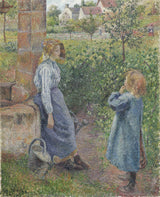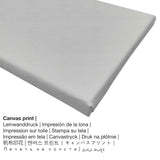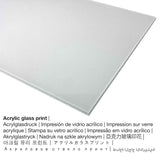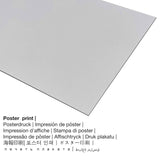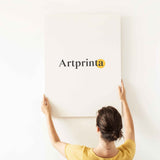Camille Pissarro, 1882 - Nwanyị na Nwatakịrị na Ọdịmma - mbipụta nka mara mma
Ụtụ gụnyere. Mbupu gbakọrọ na ndenye ọpụpụ.
Supplemental information from Art Institute Chicago (© - Art Institute Chicago - www.artic.edu)
By the 1880s, Camille Pissarro, like most of his Impressionist colleagues, sought an alternative to the style he had employed over the previous decade, deciding to focus on figures rather than landscapes. Of the 36 paintings he showed at the seventh Impressionist exhibition, in the spring of 1882, 27 were figural. Woman and Child at the Well is one of a series of works depicting peasant girls taking a break from their chores, their poses and gestures suggesting narratives that remain ambiguous. As the model for the boy in this composition, Pissarro used his fourth son, Ludovic-Rodolphe, who was four years old at the time.
Kedu ụdị ngwaahịa anyị na-enye?
In 1882 nwoke French artist Camille Pissarro tee ihe a 19th narị afọ work of art. The original measures the size of 81,5 × 66,4 cm (32 1/8 × 26 1/8 in). Mmanụ na kwaaji was applied by the French artist as the technique for the work of art. "Inscribed lower left.: C.Pissarro / 82" is the painting's inscription. Furthermore, this artwork is included in the Ụlọ ọrụ Art nke Chicago digital collection, which is one of the world’s great art museums, housing a collection that spans centuries and the globe. This work of art, which is part of the ngalaba ọha is included with courtesy of Art Institute Chicago. Moreover, the artwork has the creditline: Potter Palmer Collection. Further, the alignment is in Eserese format na nwere akụkụ ruru nke 1: 1.2, nke pụtara na ogologo bụ 20% mkpụmkpụ karịa obosara. The artist, painter Camille Pissarro was an artist, whose style can primarily be assigned to Impressionism. The Impressionist painter lived for 73 afọ, born in 1830 in Charlotte Amalie, Virgin Islands of the United States and died in the year 1903 in Paris, Ile-de-France, France.
Nhọrọ akụrụngwa enwere ike
Maka ngwaahịa ọ bụla anyị na-enye ihe dị iche iche & nha. Họrọ nha na ihe kacha amasị gị n'ime nhọrọ ndị a:
- Metal (aluminium debond mbipụta): Aluminium Dibond prints are prints on metal with a true depth effect. The Aluminium Dibond Print is your perfect introduction to art prints with aluminum. For the Direct Aluminium Dibond option, we print the selected artpiece on the surface of the aluminum composite. The colors are luminous and vivid in the highest definition, the details of the print are crisp and clear.
- Mbipụta akwụkwọ mmado (akwa akwa akwa): The poster is a printed sheet of cotton canvas with a granular surface texture. Please keep in mind, that depending on the absolute size of the poster print we add a white margin of something between 2-6cm round about the artwork, which facilitates the framing with a custom frame.
- Mbipụta iko acrylic (nke nwere ezigbo mkpuchi iko): A glossy acrylic glass print, which is often named as a plexiglass print, will turn an original into beautiful décor and is a distinct alternative option to canvas and aluminidum dibond prints. The artwork will be custom-made thanks to modern UV direct printing technology. This makes vibrant, impressive print colors. The great advantage of a plexiglass fine art print is that contrasts as well as smaller painting details become more identifiable with the help of the fine tonal gradation of the picture.
- Kwaaji: A printed canvas stretched on a wood stretcher frame. Besides, canvas print makes a homelike and comfy ambience. The great advantage of canvas prints is that they are relatively low in weight, meaning that it is easy to hang your Canvas print without any wall-mounts. Canvas prints are suitable for any type of wall.
Tebụl onye na-ese ihe
| Ihe nkiri: | Camille Pissarro |
| Aha ndi ozo: | Pissarro Jacob-Abraham-Camille, pissarro c., c. pissarro, Pissarro, Pissarro Jacob Abraham Camille, camille pissaro, Pissaro Camille Jacob, פיסארו קאמי, Pissarro C., Pissaro, Pissarro Camille Jacob, camille pisarro, Pisarro Camille, Pissaro Camille, Camille Pissarro, פיסארו קמי, Camille Jacob Pissarro, Pisaro Ḳami, c. pissaro, Pissarro Camille, camillo pissarro, pissarro c.f. |
| Gender: | nwoke |
| Obodo onye nka: | French |
| Ọrụ onye na-ese ihe: | onye na-ese ihe, omenkà |
| Obodo onye nka: | France |
| Nhazi nke onye nka: | omenkà nke oge a |
| styles: | Mmetụta |
| Nwụrụ na afọ nke: | 73 afọ |
| Afọ amụrụ: | 1830 |
| Ebe amụrụ onye: | Charlotte Amalie, Virgin Islands nke United States |
| Nwuru: | 1903 |
| Obodo ọnwụ: | Paris, Ile-de-France, France |
Ozi ndabere gbasara akụkụ nka pụrụ iche
| Aha ọrụ nka: | "Woman and Child at the Well" |
| Nhazi: | sere |
| Okwu nche anwụ: | nkà nke oge a |
| Nhazi oge: | 19th narị afọ |
| Emepụtara na: | 1882 |
| Afọ nka: | karịa afọ 130 |
| Ọkara nke ihe osise izizi: | mmanụ na kwaaji |
| Akụkụ izizi nka: | 81,5 × 66,4 cm (32 1/8 × 26 1/8 na) |
| Akara aka na nka nka: | inscribed lower left.: C.Pissarro / 82 |
| Egosiputara na: | Ụlọ ọrụ Art Chicago |
| Ebe ngosi nka: | Chicago, Illinois, Njikota Obodo Amerika |
| Webụsaịtị ihe ngosi nka: | www.artic.edu |
| Ụdị nka nka: | ngalaba ọha |
| Site n'aka: | Ụlọ ọrụ Art Chicago |
| kreditline ọrụ nka: | Nchịkọta Potter Palmer |
Nkọwa ngwaahịa
| Nkewa edemede: | nka nka |
| Mmeputakwa: | dijitalụ mmeputakwa |
| Usoro nhazi: | mbipụta dijitalụ (Mbipụta UV ozugbo) |
| Ihe ngosi: | emepụtara na Germany |
| Stockdị ngwaahịa: | na mmepụta ihe |
| Ihe eji eme atụmatụ: | mgbidi gallery, mgbidi ndozi |
| Nhazi nka nka: | usoro eserese |
| Oke akụkụ: | ( Ogologo: obosara) 1: 1.2 |
| Mmetụta akụkụ onyonyo: | ogologo bụ 20% mkpụmkpụ karịa obosara |
| Nhọrọ ihe dị: | acrylic glass print (nwere ezigbo mkpuchi iko), mbipụta akwụkwọ mmado (akwụkwọ kwaaji), mbipụta ọla (aluminium dibond), mbipụta akwụkwọ. |
| Nhọrọ nke Canvas Mbipụta (akwa akwa na etiti ihe ndọtị): | 50x60cm - 20x24", 100x120cm - 39x47", 150x180cm - 59x71" |
| Mbipụta iko acrylic (nke nwere ezigbo mkpuchi iko): | 50x60cm - 20x24", 100x120cm - 39x47" |
| Ụdị akwụkwọ mmado (akwụkwọ kwaaji) dị iche iche: | 50x60cm - 20x24", 100x120cm - 39x47" |
| Ụdị nha ebipụta aluminom: | 50x60cm - 20x24", 100x120cm - 39x47" |
| Nhazi nke nnomi nka: | na-enweghị etiti |
Nkwupụta iwu: We try everything to depict our art products as closely as possible and to exhibit them visually in our shop. Still, the colors of the print materials and the print result can differ marginally from the representation on the monitor. Depending on your screen settings and the nature of the surface, color pigments might not be printed 100% realistically. Since all fine art prints are processed and printed manually, there might also be minor differences in the motif's size and exact position.
© echebe nwebiisinka - www.artprinta.com (Artprinta)

